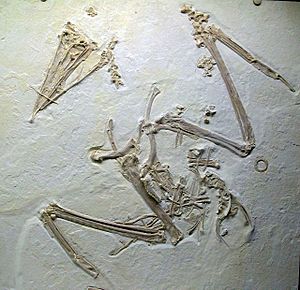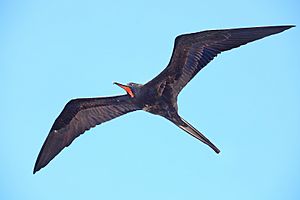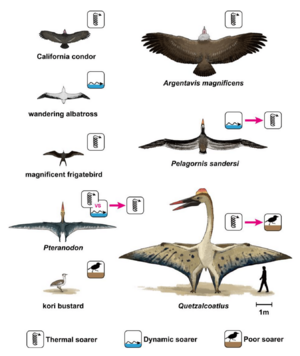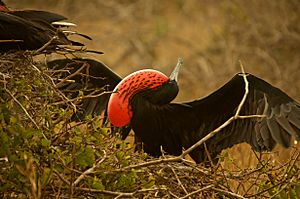Frigatebird facts for kids
Quick facts for kids Frigatebird |
|
|---|---|
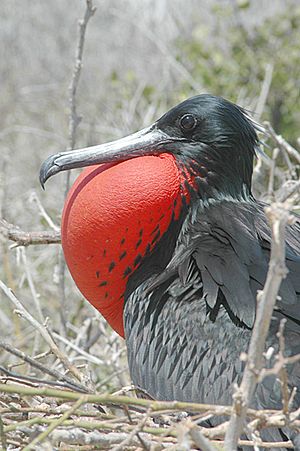 |
|
| Male magnificent frigatebird (Fregata magnificens) displaying gular pouch, Galápagos Islands. |
|
| Scientific classification |
|
| Kingdom: | Animalia |
| Phylum: | Chordata |
| Class: | Aves |
| Order: | Suliformes |
| Family: | Fregatidae Degland & Gerbe, 1867 |
| Genus: | Fregata Lacépède, 1799 |
| Type species | |
| Pelecanus aquilus (Ascension frigatebird) Linnaeus, 1758
|
|
| Species | |
|
|
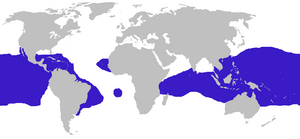 |
|
| Range map | |
Frigatebirds are amazing seabirds found in warm, tropical parts of the world. There are five types, all belonging to one group called Fregata. These birds are mostly black. They have long, deeply forked tails and long, hooked beaks.
Female frigatebirds have white bellies. Males have a bright red throat pouch. They puff this pouch up like a balloon to attract females during breeding season. Their wings are super long and pointed. They can stretch up to 2.3 meters (7.5 feet) wide! This makes their wings the largest compared to their body weight of any bird.
Frigatebirds can soar on wind currents for weeks. They spend most of their day flying and hunting for food. At night, they rest on trees or cliffs. They mostly eat fish and squid. They catch these when bigger animals like tuna chase them to the water's surface. Frigatebirds are also known as kleptoparasites. This means they sometimes steal food from other seabirds. They even snatch chicks from nests!
Frigatebirds nest in groups, usually on remote islands. They build simple nests in low trees or on the ground. A female lays only one egg each time they breed. Raising a chick takes a very long time. Because of this, frigatebirds can only breed every two years.
Contents
Frigatebirds: Masters of the Sky
Frigatebirds are related to cormorants, darters, gannets, and boobies. Three types of frigatebirds are common: the magnificent, great, and lesser frigatebirds. But two types are in danger: the Christmas Island and Ascension Island frigatebirds. They only breed on one small island each. The oldest frigatebird fossils are about 50 million years old. These ancient birds, called Limnofregata, lived in freshwater. They had shorter beaks and longer legs than today's frigatebirds.
What's in a Name?
The name "Frigate Bird" was first used in 1738. It came from French sailors who called the bird la frégate. This means "frigate" or "fast warship." The name fits because frigatebirds are very fast and agile flyers.
When Christopher Columbus saw frigatebirds in 1492, he called them rabiforçado. This means "forktail" in Spanish. English sailors in the Caribbean called them "Man-of-War birds." This name was used by explorer William Dampier in 1697. He wrote about how the bird looks like a kite and catches fish without touching the water.
How Frigatebirds Are Classified
Long ago, frigatebirds were grouped with pelicans and other water birds. This was because they all have feet where all four toes are connected by webbing. They also have a throat pouch. In 1799, the genus Fregata was created just for frigatebirds.
Scientists later studied their bones and even their DNA. They found that frigatebirds are quite unique. They are now in their own group called Suliformes. This group also includes gannets, boobies, cormorants, and darters.
Ancient Frigatebirds
Fossils of ancient frigatebirds, like Limnofregata, show they lived in freshwater. This is different from today's frigatebirds, which live near oceans. These old birds had shorter, less hooked beaks. They also had longer legs. Fossils have been found in the western United States. Some are 48 to 55 million years old! These fossils help us understand how frigatebirds have changed over millions of years.
Types of Living Frigatebirds
| Frigatebird Family Tree | |||||||||||||||||||||||||||
|
There are five types of frigatebirds alive today. For a long time, people thought there were only two. But in 1914, an Australian scientist named Gregory Mathews identified all five. DNA studies show that these five types are quite similar. They likely came from a common ancestor about 1.5 million years ago.
| Living species of frigatebirds | |||
| Common and binomial names | Image | Description | Range |
|---|---|---|---|
| Magnificent frigatebird (Fregata magnificens) Mathews, 1914 |
 |
This is the largest frigatebird, up to 114 cm (45 in) long. Males are all black with a bright red throat pouch. Females are brownish-black with a white chest. | Found in tropical Atlantic areas. They breed in Florida, the Caribbean, and along the Pacific coast of the Americas. |
| Ascension frigatebird (Fregata aquila) (Linnaeus, 1758) |
 |
Males look like magnificent frigatebirds but are smaller. Females are brownish-black with a rusty brown back and chest. | Lives near Ascension Island in the tropical Atlantic Ocean. They breed on a small island nearby. |
| Christmas frigatebird (Fregata andrewsi) Mathews, 1914 |
 |
Males have a white, egg-shaped patch on their belly. Their black feathers have a green shine. Females have dark upper parts and a white belly and collar. | Breeds only on Christmas Island in the eastern Indian Ocean. |
| Great frigatebird (Fregata minor) (Gmelin, 1789) |
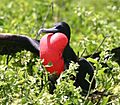 |
Males are black with a green shine on their back. Females have dark upper parts and a black head with a white collar. | Found in tropical Indian and Pacific oceans. They breed on islands with lots of plants. |
| Lesser frigatebird (Fregata ariel) (G. R.Gray, 1845) |
 |
This is the smallest type, about 75 cm (30 in) long. Males are black with a greenish shine and white patches under their wings. Females have dark upper parts and a black head with a white belly and collar. | Lives in tropical and subtropical waters of the Indian and Pacific Oceans. |
What Frigatebirds Look Like
Frigatebirds are large, sleek seabirds. They are mostly black. All five types look quite similar. The magnificent frigatebird is the biggest, reaching 114 cm (45 inches) long. The lesser frigatebird is smaller, about 71 cm (28 inches) long.
Female frigatebirds are larger and heavier than males. They usually have white markings on their undersides. Frigatebirds have short necks and long, thin, hooked beaks. Their long, narrow wings can spread up to 2.3 meters (7.5 feet). Their tails are deeply forked, which helps them steer when flying. This gives them a unique 'W' shape in the sky.
Frigatebirds have very light bones, which make up only 5% of their body weight. This helps them fly so well. Their chest muscles are very strong. They weigh as much as their feathers, together making up half their body weight!
Male frigatebirds have a special red throat pouch. They inflate this pouch like a big balloon to attract females during mating season. These pouches deflate slowly. So, if a male is disturbed, he might fly off with his pouch still puffed up!
Frigatebirds stay in the air and do not land on the ocean. Their feathers don't produce much oil, so they would get wet and heavy if they landed on water. Also, with their long wings, it would be very hard for them to take off from the sea.
Where Do Frigatebirds Live?
Frigatebirds live over tropical oceans. They use warm air currents, called updrafts, to soar high in the sky. They are found where there is plenty of food, like flying fish, and where trade winds help them fly. They rarely go to colder areas. Adult frigatebirds usually stay near the islands where they breed.
However, young birds can travel very far. Some have been recorded flying up to 6,000 kilometers (3,700 miles)! One male great frigatebird flew 4,400 km (2,700 miles) from Africa to the Maldives. Another magnificent frigatebird was seen in Michigan, far from its usual tropical home.
How Do Frigatebirds Behave?
Frigatebirds are amazing flyers. They have the largest wing area compared to their body weight of any bird. This allows them to soar almost constantly, rarely flapping their wings. One great frigatebird was tracked flying for two months without landing! They can fly higher than 4,000 meters (13,000 feet) in freezing conditions.
Like swifts, they can even sleep while flying. Scientists found they often sleep using only one side of their brain at a time. This usually happens at night while they are flying higher up. They might sleep for less than an hour in mid-air.
Frigatebirds are long-lived birds. Some great frigatebirds have been found to be over 37 years old, and one was at least 44!
Even though they have dark feathers in hot climates, frigatebirds have ways to stay cool. They fluff up their feathers to let air circulate. They can also stretch out their wings to release heat. Males often flutter their throat pouches to cool down.
Frigatebirds use warm air currents, called thermals, to glide. This is different from birds like albatrosses, which use winds created by waves.
Frigatebird Life Cycle and Reproduction
Frigatebirds usually breed on remote islands. They form colonies with up to 5,000 birds. Within these colonies, they often nest in smaller groups of 10 to 30 birds. Breeding can happen at any time of year. It often starts when the dry season begins or when there is lots of food.
Male frigatebirds have very special mating displays. They gather in groups and show off to females flying above. They point their beaks up, inflate their red throat pouches, and vibrate their wings. They also make drumming sounds and sometimes whistle. A female chooses a male and lets him hold her beak. They also do a "head-snaking" dance together.
After mating, the male usually gathers sticks for the nest. The female then builds a loose nest, which she strengthens with her droppings. Frigatebirds prefer to nest in trees or bushes. If these are not available, they will nest on the ground.
A female lays only one white egg. The egg is quite large, weighing up to 6-7% of the mother's body weight. Both parents take turns incubating the egg for 41 to 55 days. When the chicks hatch, they are naked and later grow white downy feathers.
Parents guard the chicks constantly for the first 4-6 weeks. They feed them in the nest for 5-6 months. Both parents feed the chick for the first three months. After that, the male often leaves, and the mother feeds the chick for another six to nine months. Chicks eat by putting their heads into their parents' throats to get partially digested food.
Raising a chick takes so long that frigatebirds usually breed only every other year. This long period of parental care is one of the longest among all birds. Frigatebirds also take many years to become adults. Great frigatebirds in the Galapagos Islands only start breeding when they have their full adult feathers. This happens when females are 8-9 years old and males are 10-11 years old.

What Do Frigatebirds Eat?

Frigatebirds hunt over the open ocean. They can fly up to 500 km (310 miles) from land to find food. They do not land on the water. Instead, they snatch prey from the surface with their long, hooked beaks. They mostly catch small fish, like flying fish, that are chased to the surface by bigger predators like tuna and dolphinfish. They also eat squid. Sometimes, they eat jellyfish and larger plankton.
Frigatebirds have learned to follow fishing boats. They will take fish from the boats' holding areas. Fishermen also look for frigatebirds. This is because the birds often fly above areas where large marine predators, like tuna, are hunting. Frigatebirds also sometimes eat the eggs and young of other seabirds, like boobies and terns.
Frigatebirds are famous for stealing food from other seabirds. They use their speed and agility to chase birds like boobies and tropicbirds. They harass them until they throw up their last meal. Frigatebirds might attack birds after they catch food. Or they might wait high above seabird colonies for parents to return with food.
Even though they are known for stealing, this behavior is not their main way of getting food. It's more like a supplement to what they catch themselves. One study found that frigatebirds got only about 5% of their food by stealing. At most, they could get 40% this way.
Unlike most other seabirds, frigatebirds drink freshwater. They swoop down and scoop it up with their beaks.
Protecting Frigatebirds
Two of the five frigatebird species are in danger. The Christmas Island frigatebird is critically endangered. In 2003, only about 1,200 breeding pairs were counted. Their numbers have dropped because their breeding areas were destroyed during World War II. Dust from mining also hurt them.
The Ascension frigatebird is vulnerable. Its population is about 12,500 birds. These birds used to breed on Ascension Island. But feral cats, brought to the island in 1815, killed them off. The birds then only bred on a small rocky island nearby. From 2002 to 2004, a program removed the feral cats. Now, some frigatebirds are starting to nest on Ascension Island again.
The other three species (magnificent, great, and lesser frigatebirds) are not currently in danger. Their populations are large. However, it's hard to count them because they move so much over the ocean.
Frigatebirds depend on large marine predators like tuna for food. So, too much fishing could reduce their food supply and harm their populations. Also, because frigatebirds nest in large, crowded groups in small areas, they are at risk from local disasters. A single event could wipe out a rare species or greatly affect common ones.
Frigatebirds and People
In some places, like Nauru, people used to catch frigatebirds. They would use captured birds as decoys to attract others. Then they would throw a weighted line to tangle the bird's wings. On Christmas Island, people used to eat frigatebirds and their eggs, but this stopped in the late 1970s. In the Hawaiian Islands, great frigatebirds were eaten, and their feathers were used for decorations.
Frigatebirds in Culture
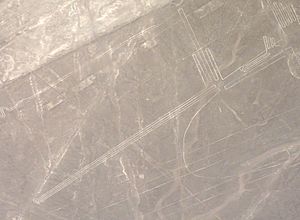
The frigatebird is an important symbol. It appears on the national Flag of Kiribati. It is also on the flag of Barbuda and is the national bird of Antigua and Barbuda.
In the Pacific, people sometimes kept tame frigatebirds. They would use them to send messages between islands. A bird taken to another island could be trusted to fly back to its original home. This practice happened in the Gilbert Islands and Tuvalu.
The great frigatebird was honored by the Rapa Nui people on Easter Island. Carvings of their birdman god, Tangata manu, show him with the frigatebird's hooked beak and throat pouch. This shows the bird was important in their ceremonies.
Sailors in the past believed frigatebirds were a sign of good luck. Seeing them meant land was nearby.
See also
 In Spanish: Rabihorcados para niños
In Spanish: Rabihorcados para niños
- List of birds by flight speed


